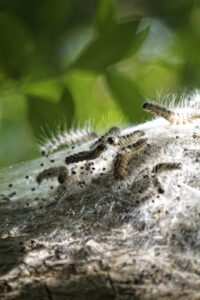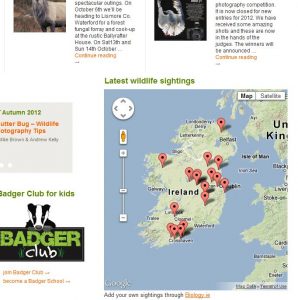
The Department of Agriculture, Food and the Marine confirmed earlier this week that colonies of the invasive Oak Processionary Moth (Thaumetopoea processionea) had been discovered on four oak trees in a Dublin housing estate. The caterpillars and the trees have been destroyed in an attempt to eradicate the pest before it becomes established. Intensive surveying of the surrounding area for further evidence of the moth are ongoing.
Ireland has Protected Zone status for the species under EU Plant Health legislation, and according to Teagasc, is the last European state to be considered free of the Oak Processionary Moth. The species was first recorded in the UK in Southeast England in 2006, and despite extensive attempts to eradicate it, has since become established.
Unsurprisingly, Oak trees (Quercus sp.), which are found throughout Ireland, are the main host species for the Oak Processionary Moth, but in areas where Oak is scarce the caterpillars have been known to feed on other species such as Birch, Hornbeam, Hawthorn, Hazel and Beech. According to the Department it is currently uncertain whether Oak Processionary Moth caterpillars can survive to complete their transformation into adult moths when feeding on species other than Oak.
As well as causing extensive damage to native Oak trees through severe defoliation, leaving trees weakened and vulnerable to secondary infection, the caterpillars also pose a risk to the health of humans, pets and livestock. If disturbed the caterpillars can release irritating hairs that trigger a severe allergic reaction, causing skin rashes, eye irritation and respiratory difficulty.
The Oak Processionary Moth overwinters as eggs, emerging the following spring, and going through 6 larval stages before pupating and emerging as adult moths from July to September.
The video below from the UK Forestry Commission explains what to look for and how to identify Oak Processionary Moth caterpillars.
You can view the Department of Agriculture, Food and the Marine’s Pest Fact Sheet for the Oak Processionary Moth here.
What to do if you think you’ve spotted the Oak Processionary Moth
Suspected sightings in Ireland should be treated with extreme caution and notified immediately to the Department of Agriculture, Food and the Marine with your contact details and geolocation of the sighting by emailing [email protected] or by telephone 01-505 8885.
The Dos and Don’ts if you find a colony of Oak Processionary Moth caterpillars
Don’t
- touch or approach nests or caterpillars
- let children touch or approach nests or caterpillars
- let animals touch or approach nests or caterpillars
- try removing nests or caterpillars yourself
Do
- warn children not to touch or approach the nests or caterpillars
- seek medical advice if you think you or someone you care for has been seriously affected
- see a vet if you think your pet or livestock has been seriously affected









